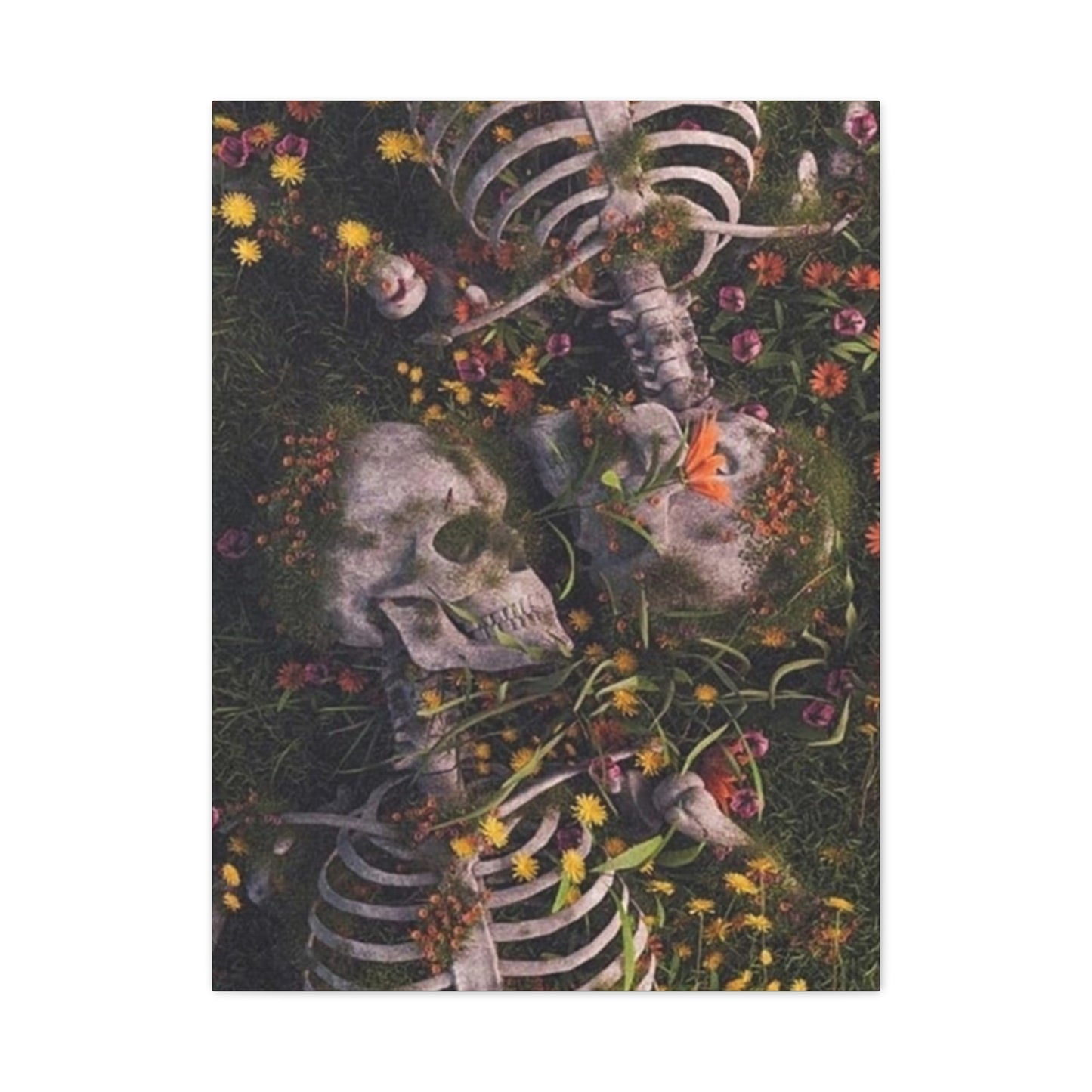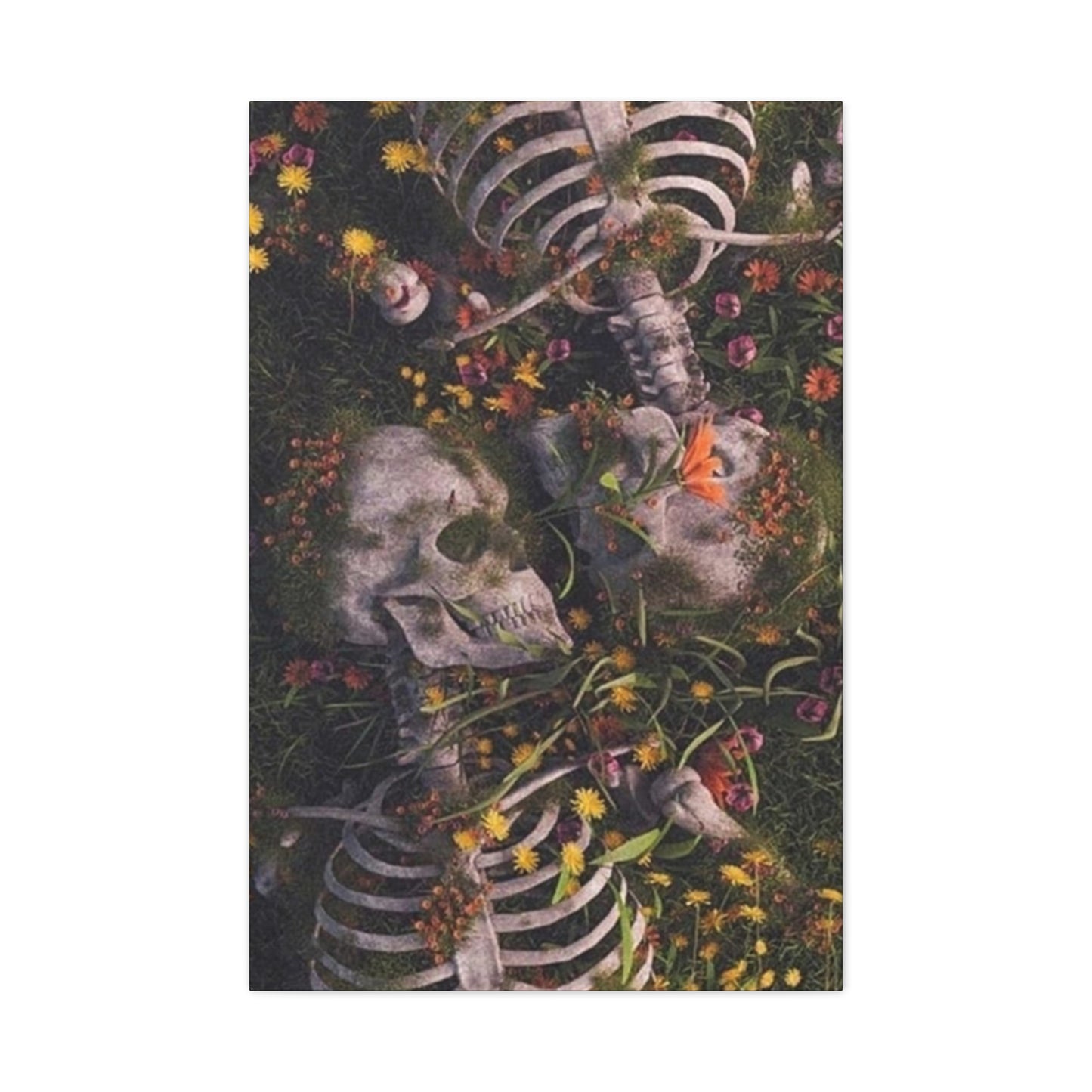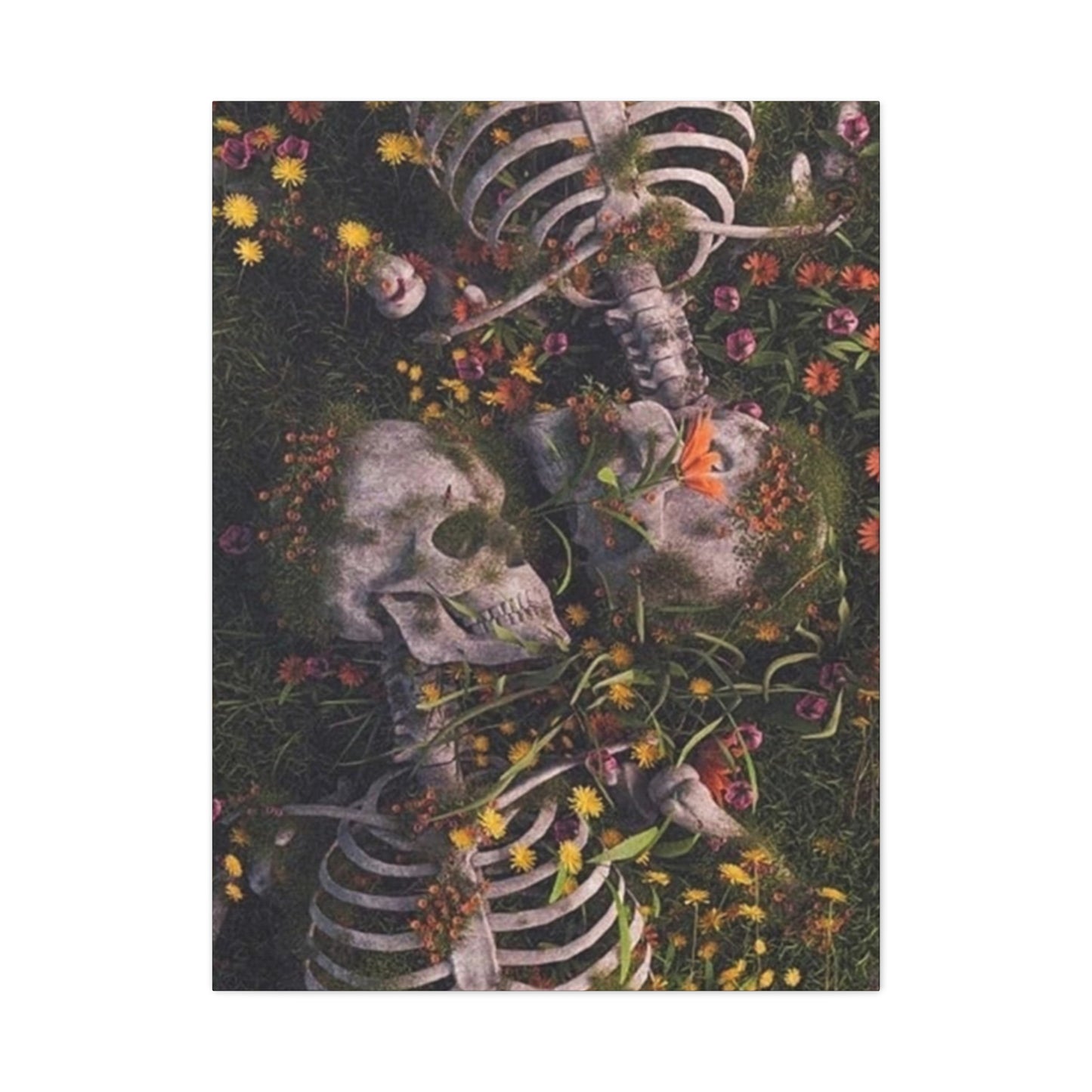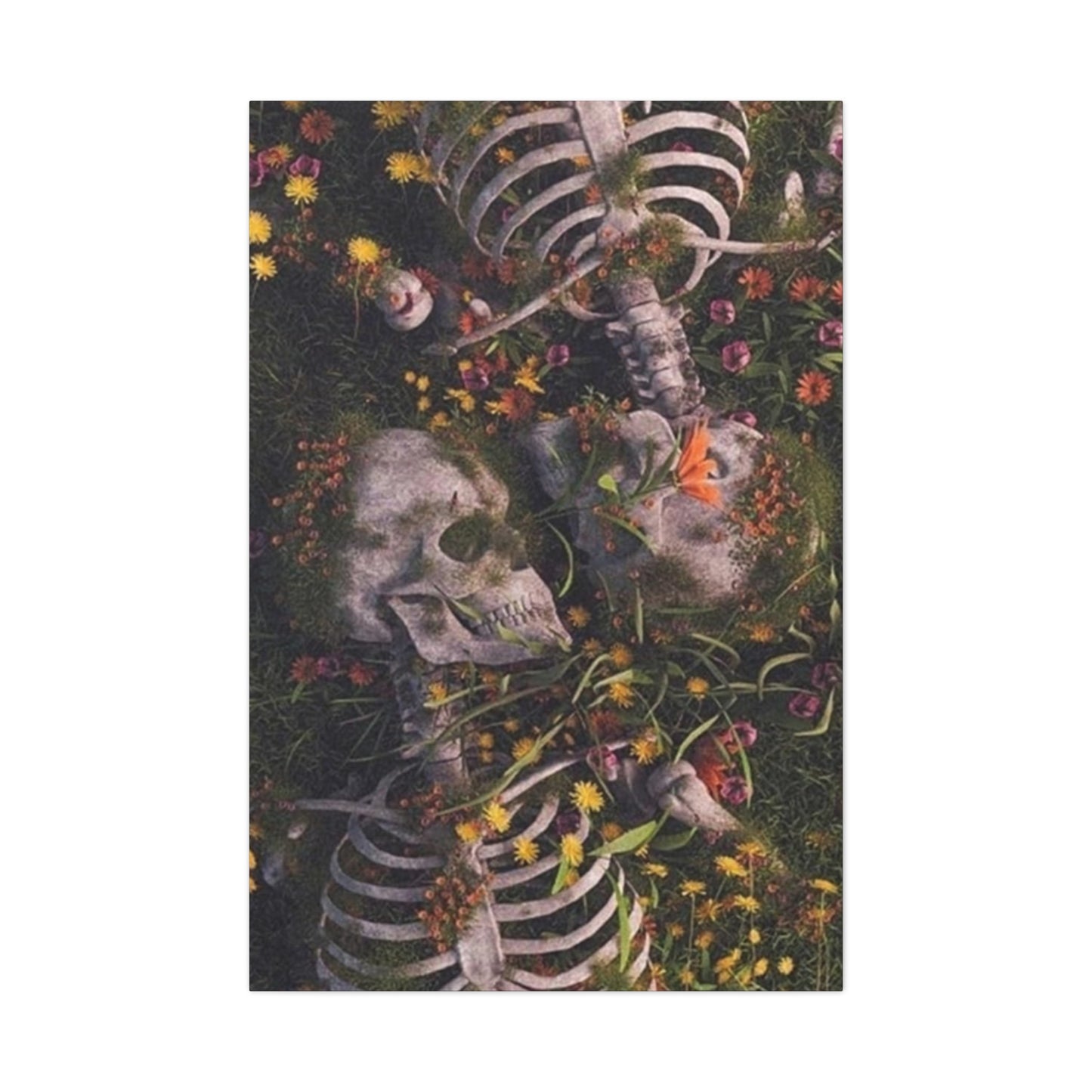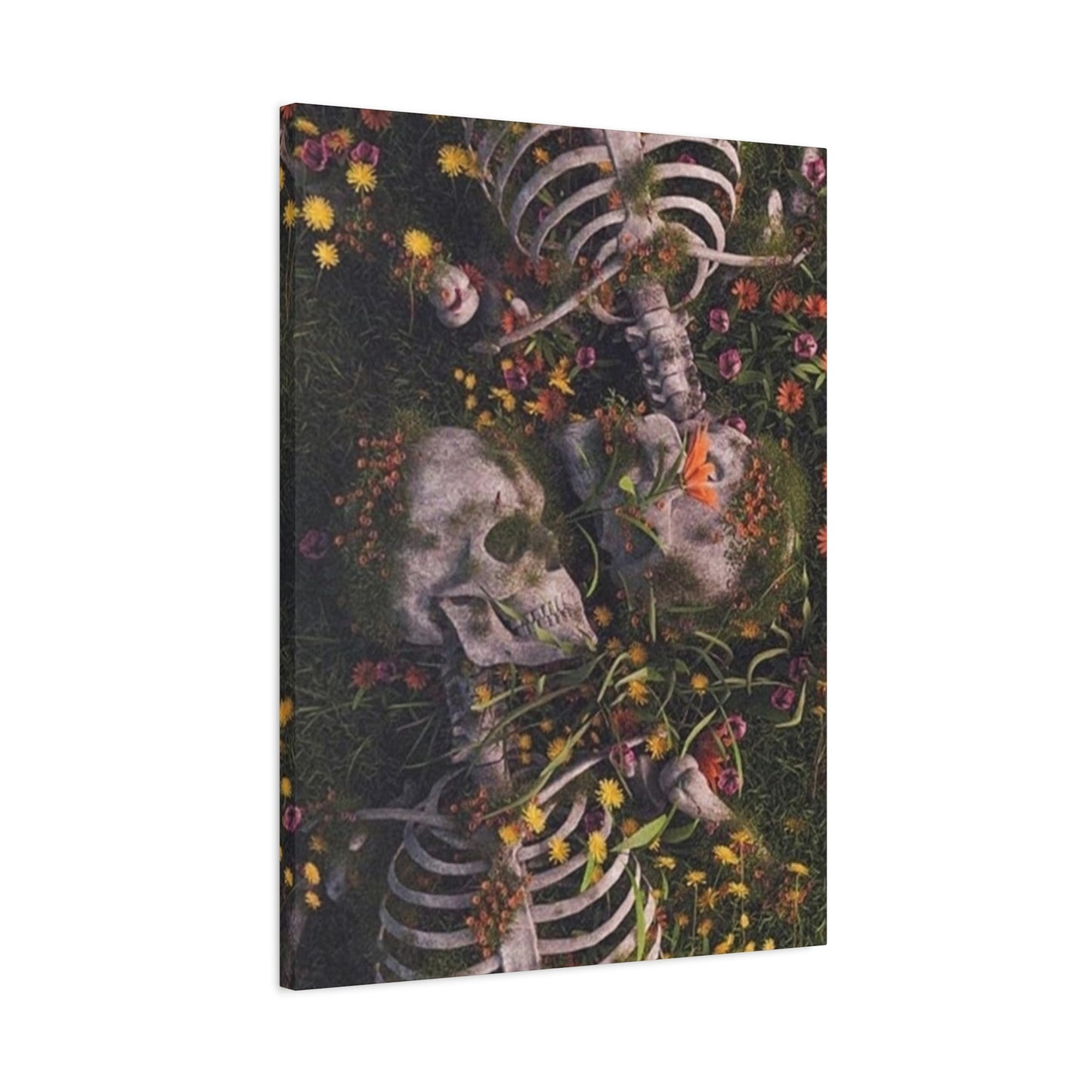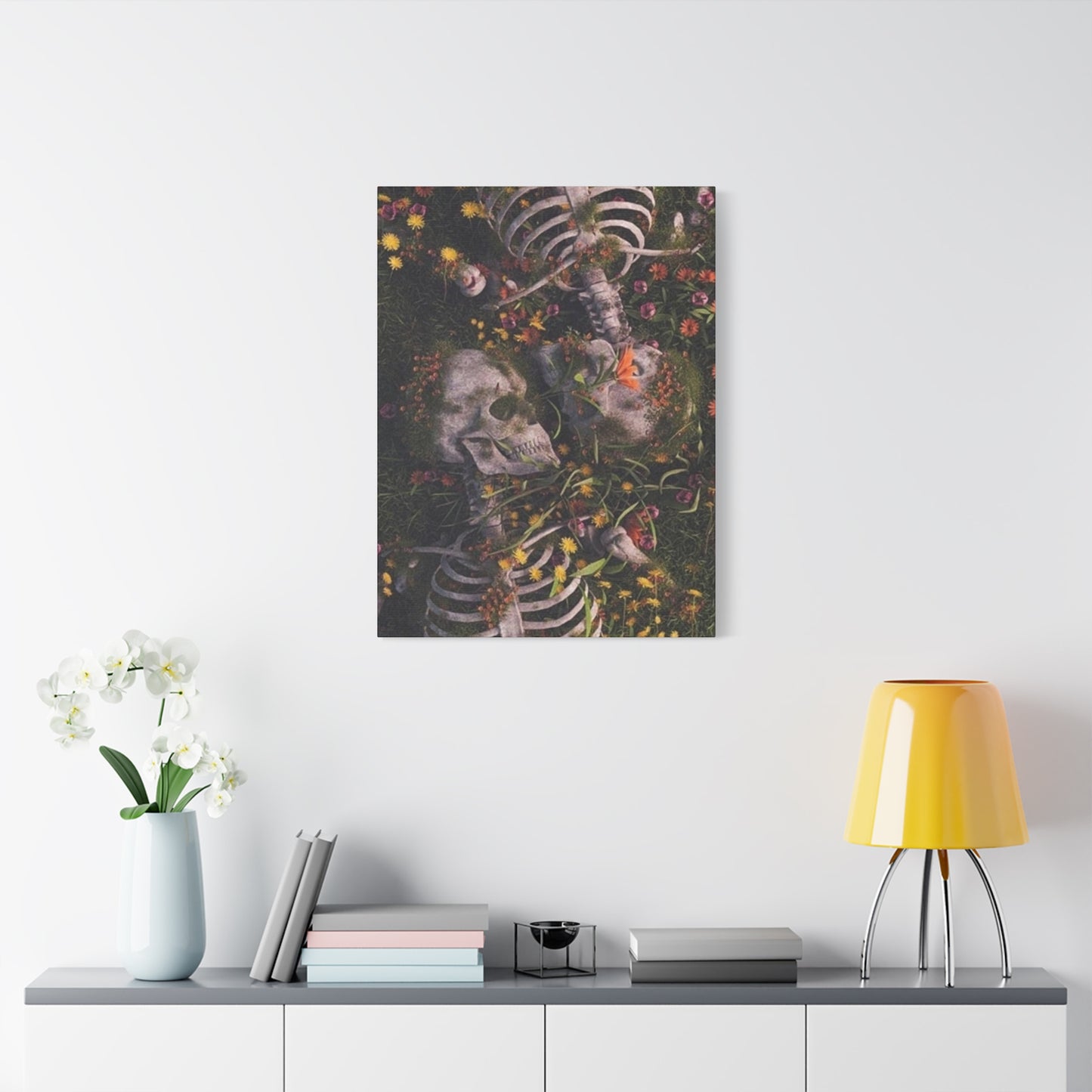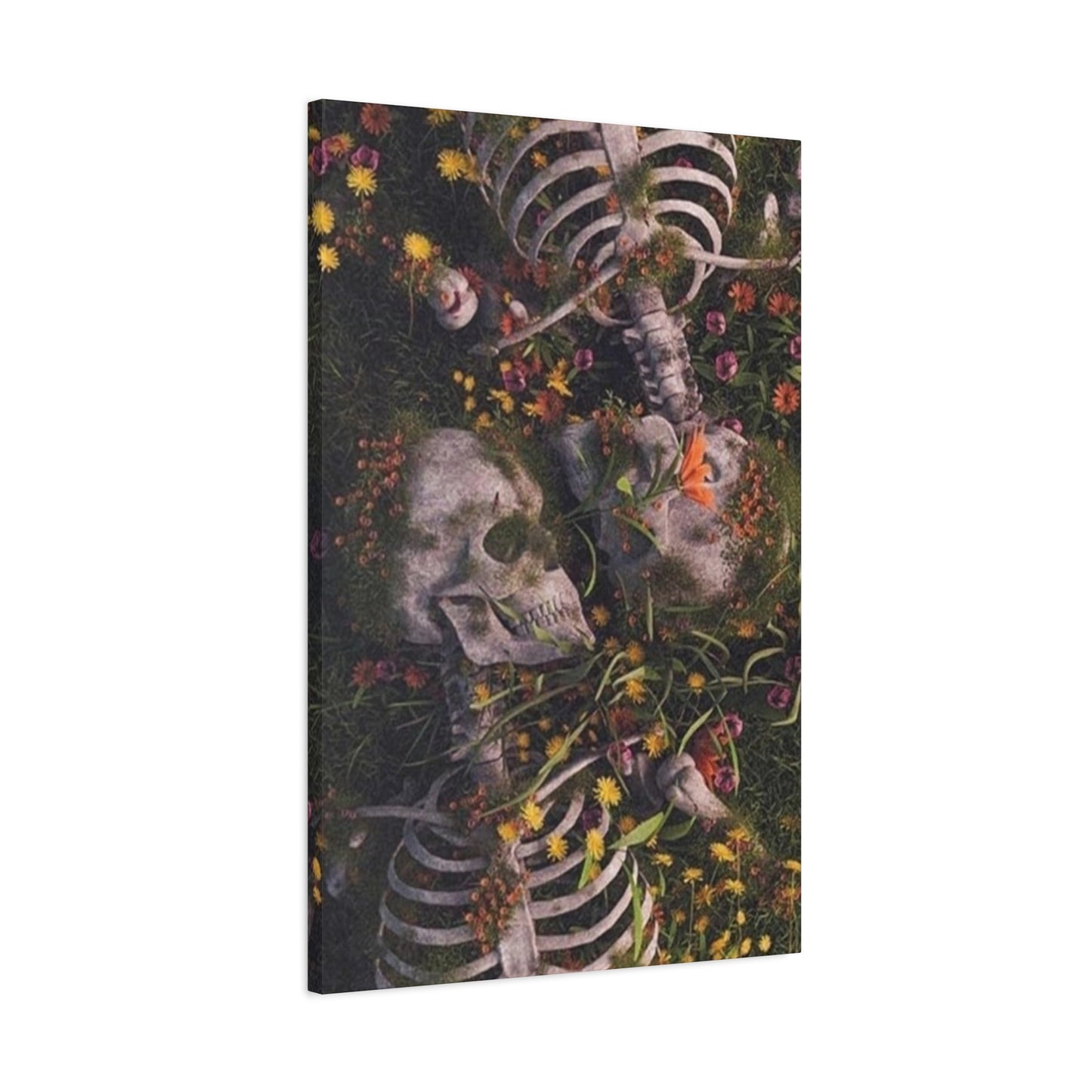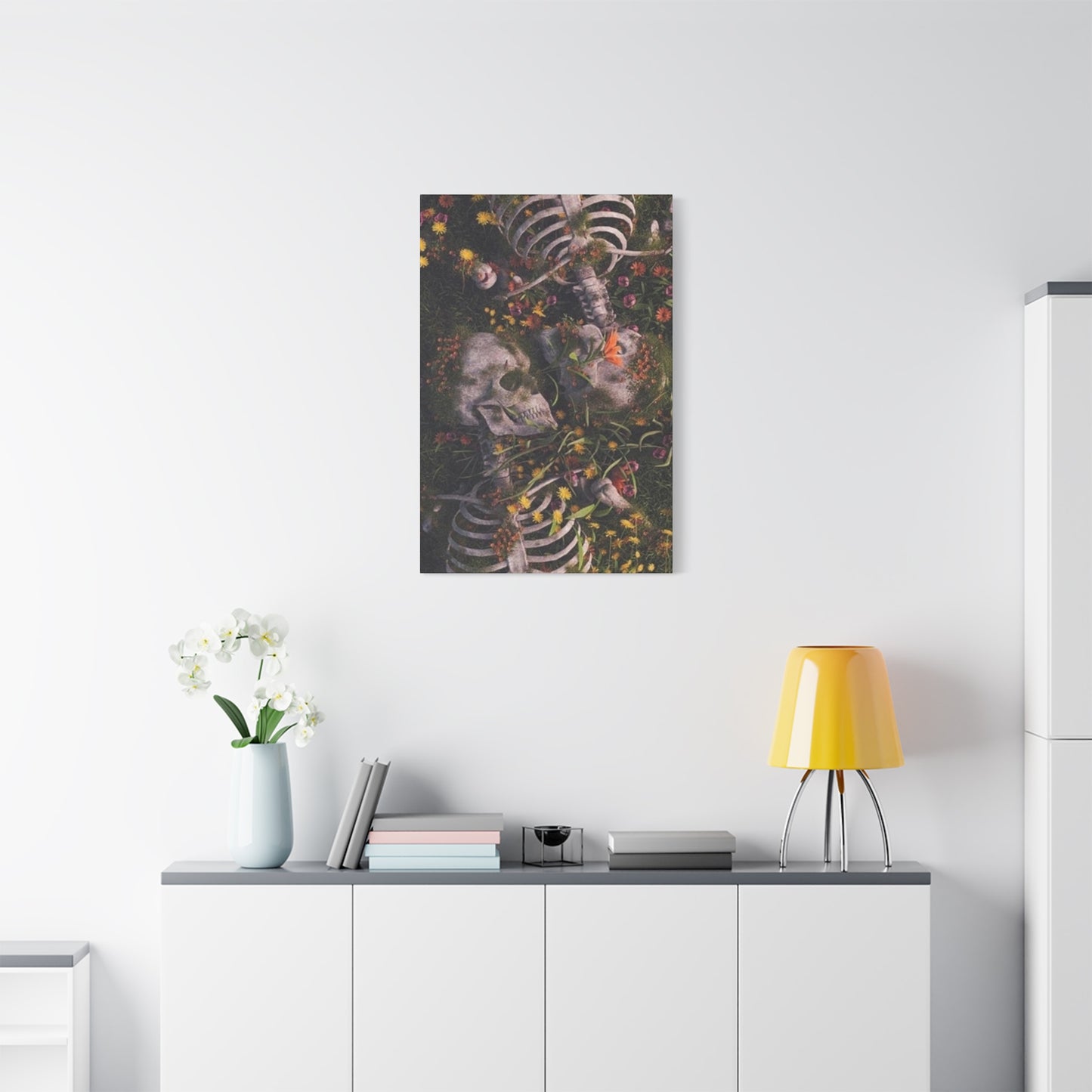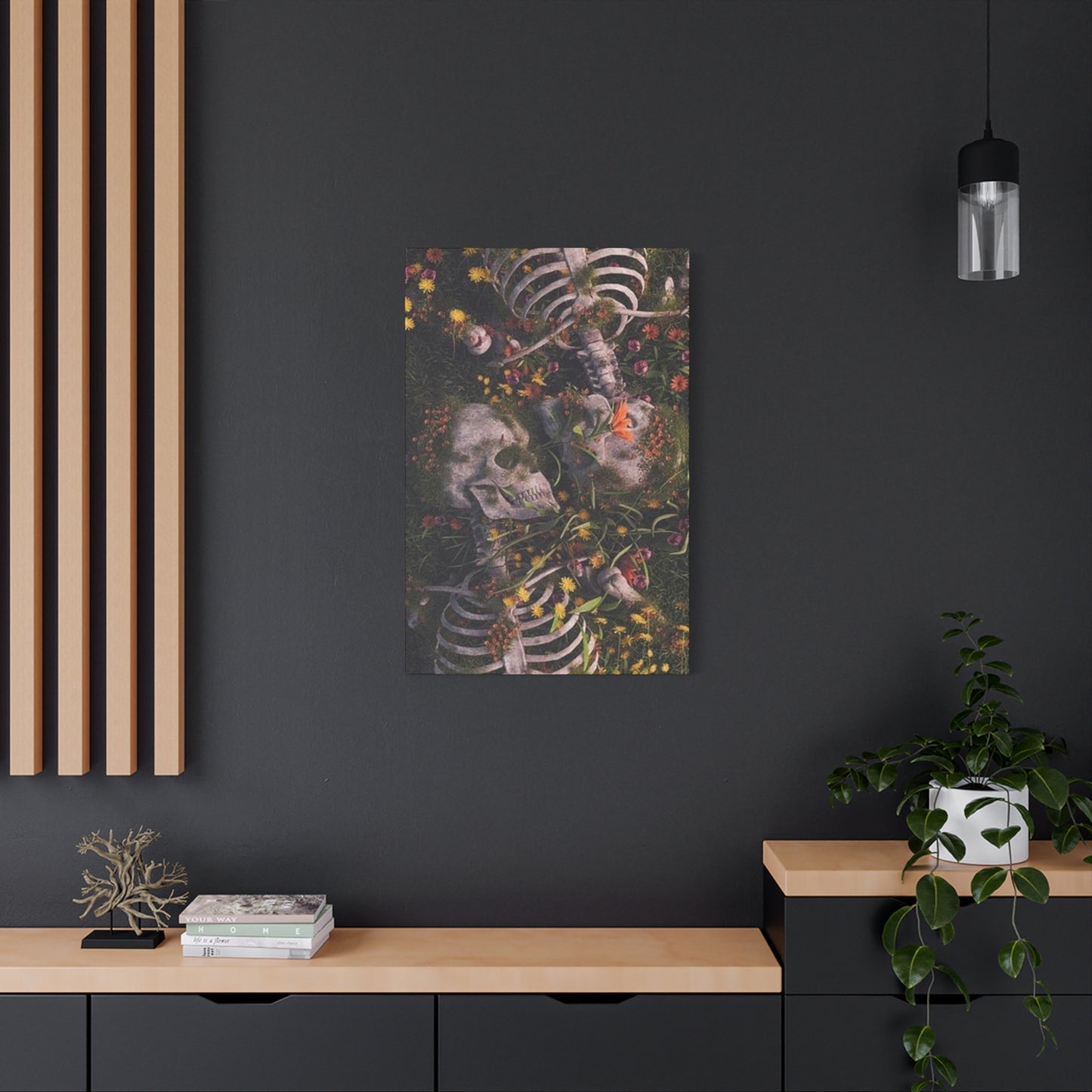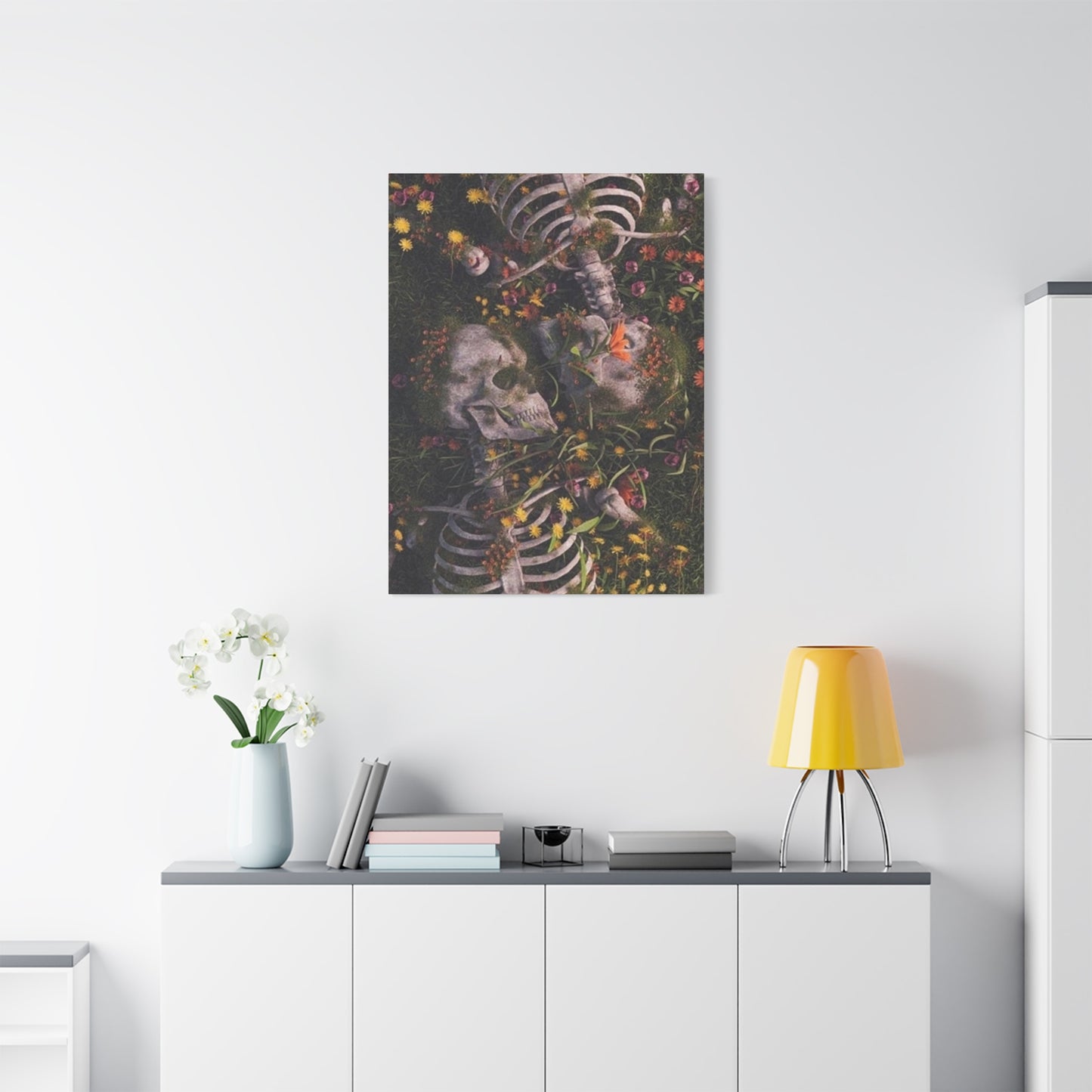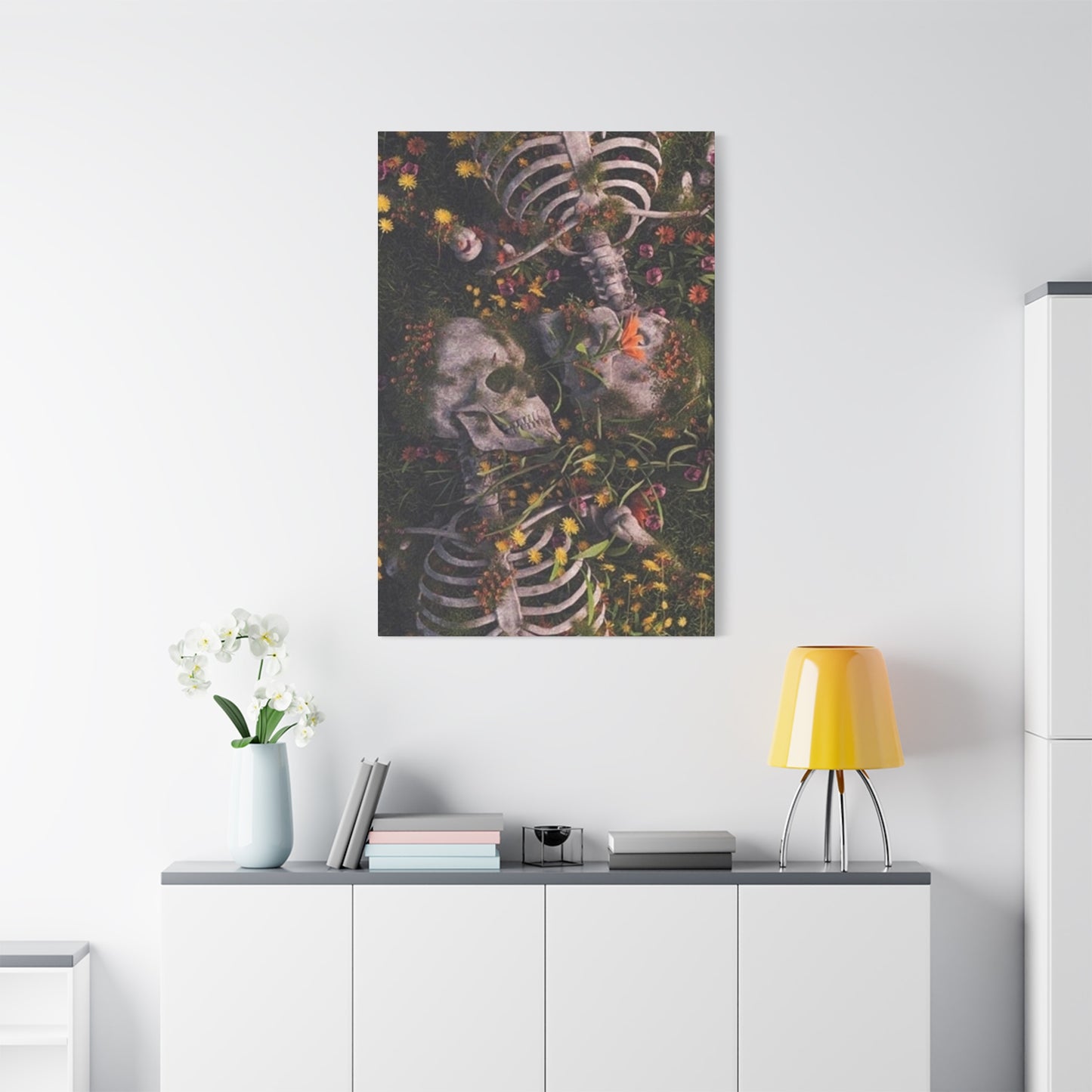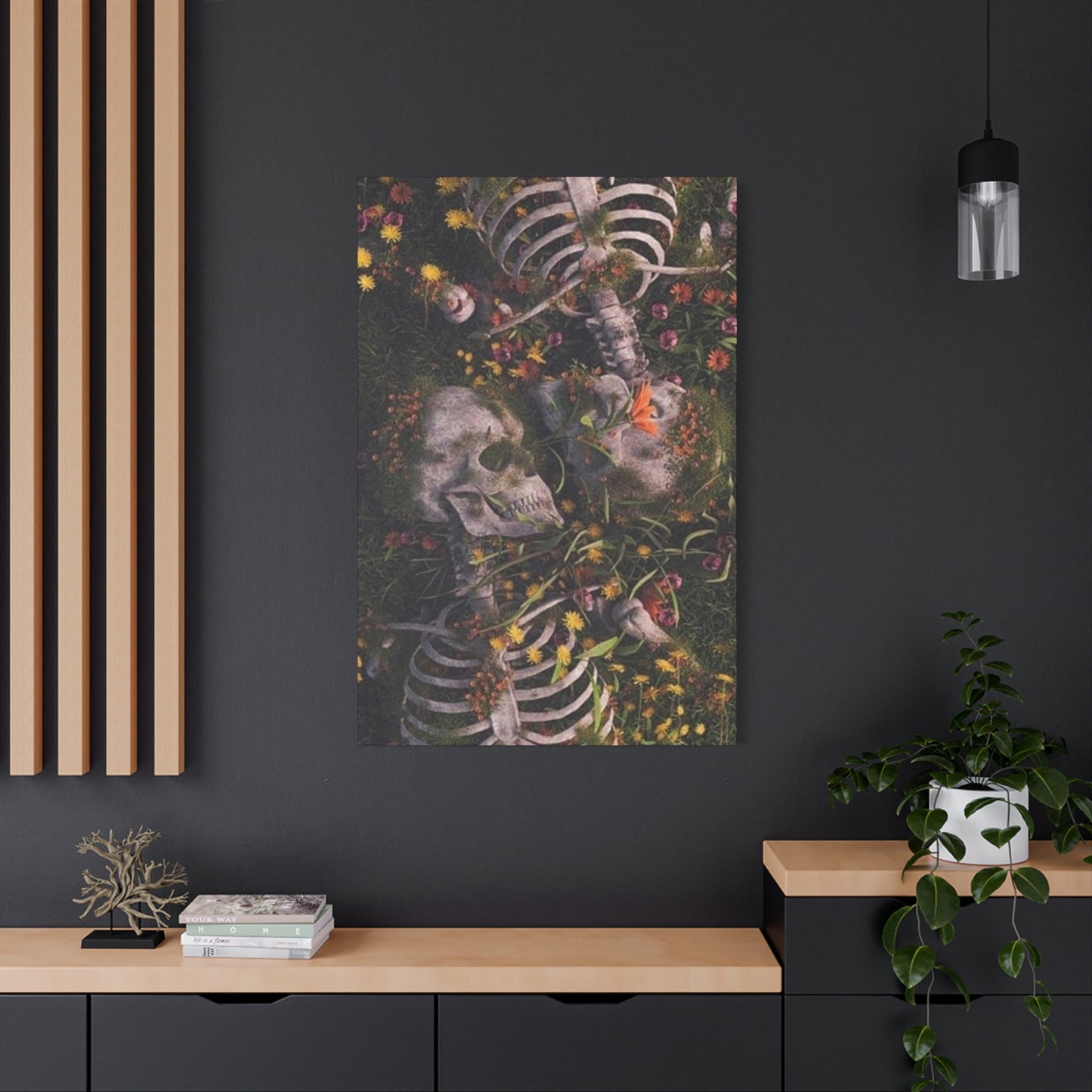Skeleton Couple Painting Wall Art: A Complete Guide to Dark Romance Aesthetics
The fascination with mortality and love has captivated artists and collectors for centuries. When these two powerful themes merge, they create something truly extraordinary. Skeleton couple wall art represents a unique intersection of romance and the macabre, offering viewers a profound meditation on the eternal nature of love beyond physical existence. This artistic movement has gained tremendous popularity in recent years, appealing to those who appreciate the darker side of romanticism and seek to express their aesthetic preferences through bold, unconventional choices.
The appeal of skeleton couple artwork extends far beyond simple shock value or gothic trends. These pieces speak to fundamental human experiences, the inevitability of mortality and the hope that love transcends our earthly limitations. Whether displayed in living rooms, bedrooms, or creative studios, skeleton couple wall art serves as a powerful reminder of what truly matters in our fleeting existence. The visual impact of two skeletal figures locked in an embrace or gazing lovingly at one another creates an immediate emotional response that resonates with viewers on multiple levels.
For those seeking to incorporate this distinctive aesthetic into their homes, the options are virtually limitless. From traditional paintings that echo classical art techniques to contemporary digital prints that push boundaries with bold colors and innovative compositions, skeleton couple wall art offers something for every taste and preference. The growing market for these pieces reflects a broader cultural shift toward embracing darker aesthetics and finding beauty in unexpected places.
Symbolic Meanings Behind Skeletal Love Imagery
The imagery of skeleton couples carries profound symbolic weight that transcends simple visual appeal. At its core, this artistic motif explores the concept of love stripped down to its most essential elements. When flesh and external appearances fall away, what remains is the fundamental structure of our being and, metaphorically, the core of our relationships. This powerful symbolism suggests that true love exists beyond physical attraction and survives even death itself.
Throughout history, skulls and skeletal figures have represented various concepts across different cultures. In Western traditions, they often symbolize mortality and the fleeting nature of earthly existence. However, when paired together in romantic poses, skeleton couples take on a different meaning entirely. They suggest that while individual bodies may perish, the connection between souls endures. This creates a poignant juxtaposition between the finite nature of physical life and the infinite potential of emotional bonds.
Many collectors are drawn to skeleton couple artwork because it challenges conventional representations of romance. Instead of depicting the idealized beauty standards often seen in romantic art, these pieces present love in its most raw and honest form. The skeletal figures are equal, stripped of all superficial differences that might separate them in life. This equality speaks to the universal nature of love and its power to unite individuals regardless of external circumstances.
The philosophical implications of skeleton couple imagery invite viewers to contemplate their own mortality and the relationships they cherish. These pieces serve as memento mori, reminders of death that paradoxically celebrate life and love. By confronting mortality through art, we gain perspective on what truly matters. The skeleton couple becomes a symbol of commitment that extends beyond the temporary nature of our physical existence, suggesting that the bonds we form have eternal significance.
Cultural interpretations of skeleton imagery vary widely, adding layers of meaning to these artworks. In some traditions, skeletal figures are viewed with fear and trepidation, while in others, they represent ancestors to be honored and respected. Skeleton couple art often bridges these cultural divides, creating a universal language of love that speaks to people from diverse backgrounds. The imagery transcends cultural boundaries by focusing on the fundamental human experience of forming deep connections with others.
Contemporary artists working with skeleton couple motifs often infuse their work with personal symbolism and meaning. Some view the skeleton as a representation of vulnerability, with the removal of protective flesh exposing the fragile framework beneath. When two skeletons embrace, it symbolizes mutual vulnerability and trust, the willingness to be completely open and exposed with another person. This interpretation resonates strongly with modern audiences seeking authentic connections in an increasingly superficial world.
The enduring popularity of skeleton couple artwork also reflects a growing comfort with discussing mortality and impermanence. Rather than shying away from these difficult topics, contemporary society is increasingly willing to engage with them through art and culture. Skeleton couple pieces provide a safe way to explore these themes while simultaneously celebrating the joy and beauty of romantic connection. This duality makes them particularly compelling for those seeking meaningful art that provokes thought and conversation.
Passionate Expressions Through Skeletal Figures
The portrayal of romance through skeletal figures might seem paradoxical at first glance, yet these artworks often convey passion and tenderness more effectively than traditional romantic depictions. Artists working in this genre have developed sophisticated visual languages for expressing love through bone structure, positioning, and symbolic elements. The result is a body of work that challenges preconceptions about beauty, romance, and artistic representation.
One common approach in skeleton couple paintings involves depicting the figures in classic romantic poses. Two skeletons might be shown holding hands, with finger bones delicately intertwined to suggest gentle affection. Others show skulls pressed together in what would be a kiss, creating an unexpectedly touching scene despite the absence of lips or flesh. These familiar romantic gestures, when performed by skeletal figures, take on new significance and emotional resonance.
The body language conveyed through skeletal positioning is crucial to communicating romantic themes. Artists carefully consider the angle of each bone, the curve of the spine, and the placement of limbs to suggest emotions that would typically be read through facial expressions or muscle tension. A skeleton leaning protectively over another conveys care and devotion. Two skeletons facing each other with foreheads touching suggest intimacy and deep connection. These subtle positional choices transform what could be clinical anatomical studies into moving portraits of love.
Many skeleton couple artworks incorporate traditional symbols of romance to reinforce their themes. Roses are particularly popular, with red blooms often placed in skeletal hands or woven through rib cages. Hearts, whether anatomically accurate or stylized, frequently appear in these compositions. Some artists include crowns, suggesting that the depicted couple reigns supreme in their own domain of eternal love. These symbolic additions help bridge the gap between the macabre subject matter and the romantic message.
The contrast between the harsh reality of skeletal remains and the soft emotions associated with romance creates a powerful tension in these artworks. This juxtaposition forces viewers to reconsider their assumptions about both subjects. Death need not be entirely morbid, and romance need not be entirely sentimental. By bringing these opposing concepts together, artists create works that are simultaneously thought-provoking and emotionally engaging.
Some skeleton couple paintings draw inspiration from famous romantic artworks throughout history, reimagining classic compositions with skeletal figures. This approach creates a dialogue between traditional art history and contemporary sensibilities. When viewers recognize references to well-known romantic paintings, they experience the familiar through a new lens, prompting fresh interpretation and understanding. This technique demonstrates how skeleton couple art exists in conversation with broader artistic traditions rather than in isolation from them.
The emotional depth achieved in skeleton couple artwork often surprises those encountering it for the first time. Despite the absence of facial features beyond eye sockets and teeth, these pieces successfully convey a wide range of emotions. Longing, joy, contentment, and devotion all find expression through careful composition and artistic technique. This demonstrates the skill of artists working in this genre and the universal nature of the emotions they seek to represent.
Dark Aesthetic Elements in Skeletal Love Art
The gothic aesthetic has long embraced darkness, mystery, and the macabre as sources of beauty and inspiration. Skeleton couple wall art fits naturally within this tradition, offering all the hallmarks of gothic style while adding romantic dimensions. The combination creates artworks that appeal to those drawn to darker aesthetics while maintaining accessibility for broader audiences through their underlying themes of love and connection.
Gothic elements in skeleton couple art often include dramatic lighting that creates strong shadows and highlights. Candlelight is a popular choice, with flames illuminating skeletal features while leaving other areas shrouded in darkness. This lighting approach enhances the mysterious quality of the pieces while creating visual drama. The interplay of light and shadow adds depth and dimension, making two-dimensional artworks feel more sculptural and present.
Architectural elements frequently appear in gothic skeleton couple compositions. Crumbling crypts, ancient arches, and weathered tombstones provide atmospheric settings for these romantic encounters. Gothic windows with their distinctive pointed arches might frame the skeletal couple, while ivy and other vegetation reclaim manmade structures in the background. These environmental details reinforce the theme of time passing and nature's eventual triumph over all human constructions, yet the love between the skeleton couple endures.
The color palette in gothic skeleton couple art tends toward rich, deep tones. Black backgrounds are common, providing stark contrast for lighter skeletal bones. Deep purples, midnight blues, and dark greens create moody atmospheres that enhance the gothic feel. When brighter colors appear, they often do so strategically, perhaps in the form of crimson roses or golden candlelight, drawing the eye and emphasizing specific elements within the composition.
Texture plays a significant role in gothic skeleton couple artwork. Artists may depict aged, weathered bone surfaces complete with cracks and imperfections that speak to the passage of time. Fabric elements like tattered clothing, flowing veils, or draped cloths add textural variety while suggesting the remnants of earthly existence. These textural details make the artworks feel more tangible and grounded despite their fantastical subject matter.
Gothic skeleton couple pieces often incorporate Victorian-era aesthetics, drawing from a period when mourning culture and death imagery were more openly displayed and discussed. Victorian mourning jewelry, elaborate funeral customs, and the period's fascination with spiritualism all influence contemporary skeleton couple art. Artists might include Victorian clothing elements, vintage frames within the composition, or other period-specific details that connect the work to this rich historical tradition.
The atmosphere created in gothic skeleton couple artwork often balances between unsettling and comforting. While skeletal imagery can be jarring, the romantic elements provide emotional warmth that counterbalances any discomfort. This equilibrium makes the pieces accessible to viewers who might not typically embrace gothic aesthetics while satisfying those deeply embedded in the subculture. The artwork exists in a unique middle ground that appeals across audience segments.
Many gothic skeleton couple pieces incorporate supernatural or mystical elements. Spectral glows might emanate from the skeletal figures, suggesting spiritual presence beyond mere bones. Mysterious mists or ethereal particles could surround the couple, indicating that their love exists in a realm beyond physical reality. These supernatural touches reinforce the idea that the depicted love transcends normal boundaries and exists in an extraordinary state.
Decorative Applications for Skeleton Couple Artwork
Incorporating skeleton couple wall art into living environments requires thoughtful consideration of placement, scale, and surrounding elements. These distinctive pieces make strong statements and deserve settings that allow them to shine while complementing the overall aesthetic of a room. When properly integrated, skeleton couple artwork becomes a focal point that defines and enhances the character of the environment.
Living rooms offer excellent opportunities for displaying skeleton couple art, particularly above seating areas where the pieces will be regularly viewed. A large skeleton couple canvas positioned over a sofa creates an immediate visual anchor for the room. The artwork becomes a conversation starter for guests while reflecting the homeowner's personal taste and willingness to embrace unconventional aesthetics. Surrounding furnishings can either contrast with or complement the artwork, depending on the desired effect.
Bedrooms provide intimate settings perfectly suited to skeleton couple imagery. The romantic themes inherent in these pieces align naturally with bedroom environments. Positioning skeleton couple art above the headboard creates a meaningful backdrop for the most personal room in the home. The symbolism of eternal love watching over the sleeping space adds layers of meaning to the decorative choice. Bedroom lighting should be considered carefully to ensure the artwork is properly illuminated during evening hours.
Home offices and creative studios benefit from the thought-provoking nature of skeleton couple artwork. These pieces can inspire creativity while providing visual interest during long work sessions. The memento mori aspect serves as a subtle reminder to use time wisely and focus on meaningful pursuits. For those in creative professions, skeleton couple art signals a willingness to explore darker themes and unconventional ideas, potentially resonating with like-minded clients or collaborators.
Dining areas might seem unconventional for skeleton couple artwork, yet many collectors successfully incorporate these pieces into eating environments. The key is selecting artworks that balance their macabre elements with sufficient beauty and artistry to remain appropriate for shared meals. More stylized or abstract skeleton couple pieces often work better in dining areas than highly realistic anatomical depictions. The artwork adds character and personality to dinner parties, distinguishing the home from more conventionally decorated spaces.
Entryways and hallways provide excellent locations for skeleton couple art, offering guests immediate insight into the homeowner's aesthetic preferences. These transitional areas benefit from bold artworks that make strong impressions. A skeleton couple piece in an entryway sets the tone for the entire home, preparing visitors for the personality and style they'll encounter in other rooms. Hallway galleries can incorporate multiple skeleton couple pieces in various sizes, creating a cohesive collection that guides movement through the home.
Bathroom environments can accommodate skeleton couple artwork, particularly in powder rooms designed for guests. The unexpected placement adds an element of surprise and humor while maintaining the romantic themes. Smaller skeleton couple prints work well in bathrooms, where wall availability is typically limited. The moisture concerns common in bathrooms require proper framing and placement away from direct water exposure to preserve the artwork.
The scale of skeleton couple artwork should be carefully matched to the dimensions of the display area. Oversized pieces make bold statements in large rooms with high ceilings, while smaller artworks suit more intimate environments. A common mistake involves selecting pieces that are too small for their intended locations, resulting in artwork that gets lost on expansive walls. Generally, art should occupy roughly two-thirds to three-quarters of the available wall width to achieve proper visual balance.
Chromatic Choices in Skeletal Romance Paintings
Color selection dramatically impacts the mood, message, and visual effectiveness of skeleton couple paintings. Artists working in this genre employ sophisticated color strategies to evoke specific emotional responses and create compelling compositions. Understanding the role of color in these artworks helps collectors make informed choices that align with their aesthetic preferences and decorative goals.
Monochromatic skeleton couple paintings using primarily black, white, and grayscale tones create striking visual impact through contrast alone. These pieces emphasize form, composition, and the sculptural quality of skeletal structures. The absence of color focuses viewer attention on the relationship between the figures and the emotional content conveyed through positioning and detail. Monochromatic works often feel more classical and timeless, connecting to long traditions of black and white artistic representation.
Warm color palettes incorporating reds, oranges, and golds infuse skeleton couple artwork with passion and intensity. Red particularly carries strong romantic associations, making it a natural choice for these pieces. When applied to skeletal figures or incorporated through environmental elements like roses or fabric, warm colors create emotional heat that contrasts with the coolness typically associated with death imagery. This temperature contrast generates visual and conceptual tension that makes the artwork more dynamic.
Cool color schemes using blues, purples, and greens create mysterious, melancholic atmospheres in skeleton couple paintings. These colors evoke nighttime, moonlight, and shadowy environments that complement gothic aesthetics. Cool tones can make skeletal figures appear more ghostly or spectral, emphasizing their otherworldly nature. Purple, with its historical associations with royalty and spirituality, adds depth and richness to compositions while maintaining the darker aesthetic appropriate to the subject matter.
High contrast approaches that juxtapose very light elements against very dark backgrounds create maximum visual impact. Pure white bones against jet black backgrounds immediately grab attention and create graphic, almost poster-like effects. This approach works particularly well for skeleton couple artwork intended as focal points in rooms with neutral color schemes. The stark contrast ensures the artwork remains visible and impactful from across the room.
Some skeleton couple paintings employ unexpected color choices that challenge viewer expectations. Neon colors, pastels, or vibrant rainbow hues might seem at odds with skeletal imagery, yet skilled artists use these unconventional palettes to create fresh interpretations of the theme. These colorful approaches can make skeleton couple art more accessible to those who appreciate the concept but prefer brighter, more optimistic aesthetics. The surprising color choices create memorable artworks that stand out in the marketplace.
Color symbolism adds additional layers of meaning to skeleton couple paintings. White might represent purity or spiritual transcendence, while black suggests mystery or the void. Gold could indicate divine love or precious value, and silver might reference moonlight or reflective meditation. Artists who understand color symbolism can encode multiple meanings into their works, creating pieces that reward careful observation and contemplation.
The background colors in skeleton couple paintings significantly affect how the central figures are perceived. Dark backgrounds make light-colored bones appear more prominent and create dramatic staging. Lighter backgrounds can make skeletal figures seem less ominous and more approachable. Textured or patterned backgrounds add visual complexity, while solid colors keep focus on the figures themselves. The relationship between figure and ground is crucial to the overall composition.
Metallic accents in skeleton couple artwork add luxurious qualities and catch light in interesting ways. Gold leaf highlights on bone surfaces create shimmering effects that suggest precious materials or divine illumination. Silver or copper metallic elements can reference jewelry, crowns, or other adornments that skeleton couples might wear. These metallic touches elevate the artwork and create visual variety within the composition.
Preservation Methods for Skeletal Couple Canvas Artwork
Proper care and maintenance of skeleton couple canvas prints ensures these artworks remain vibrant and intact for years to come. Canvas prints represent a popular format for skeleton couple art due to their affordability, durability, and aesthetic appeal. However, they require specific care approaches to prevent degradation and maintain their visual impact over time. Understanding proper preservation techniques helps collectors protect their investments.
The location where canvas prints are displayed significantly affects their longevity. Direct sunlight represents one of the greatest threats to canvas artwork, causing colors to fade and materials to degrade. Even prints with UV-resistant inks will eventually show sun damage if exposed to bright, direct light for extended periods. Ideal placement positions canvas prints away from windows or in areas where curtains or blinds can control light exposure. If displaying near windows is unavoidable, UV-filtering window films provide additional protection.
Humidity and temperature fluctuations pose serious risks to canvas prints. Excessive moisture can promote mold growth, cause warping, and deteriorate both the canvas material and printed inks. Very dry conditions may make canvas brittle and prone to cracking. Maintaining stable environmental conditions between 65-75 degrees Fahrenheit and 40-50 percent relative humidity provides optimal preservation conditions. Avoid hanging canvas prints in bathrooms or other high-moisture areas unless absolutely necessary.
Dust accumulation is inevitable over time and requires regular attention to maintain the appearance of canvas prints. A soft, dry microfiber cloth gently wiped across the surface removes surface dust without damaging the print. Avoid using cleaning products, water, or aggressive scrubbing, which can damage inks or canvas texture. For stubborn dirt or grime, professional art cleaning services offer expertise and specialized tools that safely clean canvas without causing harm.
Gallery wrap canvas prints, where the image continues around the sides of the frame, offer a modern presentation style that eliminates the need for traditional framing. These prints should be handled carefully by the wooden frame structure rather than the canvas surface to prevent fingerprints and oils from transferring to the artwork. When moving or transporting gallery wrap canvases, supporting the frame from underneath prevents stress on canvas staples and mounting points.
Varnishing canvas prints provides an additional layer of protection against dust, moisture, and UV damage. However, this process should only be undertaken with appropriate products designed for canvas prints or by professional conservators. Improper varnishing can create uneven surfaces, alter colors, or cause irreversible damage. For valuable or particularly meaningful skeleton couple canvas pieces, consulting with a professional about protective measures is worthwhile.
Storage of canvas prints when not displayed requires careful attention to prevent damage. Canvas prints should never be stored rolled tightly, as this can create permanent creases or cracks in the ink layer. If rolling is necessary for transport, use the largest diameter tube possible and roll with the image facing outward. Ideally, canvas prints should be stored flat in a climate-controlled environment, separated by acid-free paper to prevent surfaces from touching.
Regular inspection of canvas prints helps catch potential problems early. Check mounting hardware to ensure the canvas remains securely hung and hardware hasn't loosened over time. Look for any signs of canvas sagging, which might indicate the stretcher frame needs adjustment. Examine ink surfaces for any fading, cracking, or other degradation that might require intervention. Early detection of problems allows for corrections before significant damage occurs.
Considerations for Skeleton Couple Artwork
The dimensions of skeleton couple wall art significantly impact its visual presence and effectiveness in various environments. Selecting appropriate sizes requires careful consideration of wall dimensions, room proportions, viewing distances, and the desired impact of the artwork. Both small and large skeleton couple pieces offer distinct advantages and suit different applications depending on specific circumstances and aesthetic goals.
Large skeleton couple artwork, typically measuring 40 inches or more in width or height, creates commanding focal points that immediately draw attention. These substantial pieces work best in spacious rooms with ample wall area and viewing distance. A large skeleton couple canvas above a sofa or fireplace becomes the defining element of the room, anchoring the visual design. The scale allows for greater detail and complexity in the artwork, enabling viewers to discover new elements upon repeated viewing.
Oversized skeleton couple pieces require walls with sufficient surrounding clear area to avoid appearing cramped. As a general guideline, leave at least 6-12 inches of empty wall on all sides of large artwork. This breathing room prevents the piece from feeling squeezed and allows the eye to properly take in the entire composition. In rooms with standard 8-foot ceilings, the largest practical artwork dimensions typically max out around 60 inches to maintain appropriate proportions.
Medium-sized skeleton couple art, ranging from roughly 20 to 40 inches in either dimension, offers versatility that suits many environments. These pieces provide significant visual impact without overwhelming smaller rooms. Medium artwork works well in bedroom settings, home offices, or dining areas where large pieces might feel oppressive. The moderate scale allows for more flexible placement options and easier repositioning if decorating needs change.
Small skeleton couple prints measuring under 20 inches serve specialized purposes and locations. These compact pieces work excellently in gallery wall arrangements, where multiple artworks combine to create larger visual statements. Small prints suit tight areas like hallways, bathrooms, or small office nooks where larger pieces won't fit. They also provide affordable entry points for collectors beginning to explore skeleton couple art without committing to major purchases.
Gallery wall arrangements featuring multiple skeleton couple pieces in various sizes create dynamic, layered presentations. This approach allows collectors to build comprehensive displays over time, adding pieces gradually as budget and availability allow. When creating gallery walls, odd numbers of pieces typically look more balanced than even numbers. Varying the sizes creates visual interest, though maintaining consistent framing styles or color schemes helps unify the collection.
The viewing distance available in a room should inform size selection. In narrow hallways or small rooms where viewers will stand close to artwork, smaller pieces prevent viewers from needing to step back to see the entire composition. Conversely, in large great rooms or across from seating areas, bigger pieces ensure the artwork remains visible and impactful from typical viewing positions. Consider where people will be when looking at the art to select appropriate dimensions.
Vertical versus horizontal orientation affects how skeleton couple artwork interacts with its environment. Vertical pieces draw the eye upward, potentially making ceilings appear higher and rooms feel more spacious. Horizontal artwork emphasizes width and can make narrow walls appear broader. The pose and composition of skeleton couple figures often suggest natural orientations, though some designs work equally well in either format.
Frame Selection and Presentation Options
The framing choices made for skeleton couple paintings dramatically affect their final appearance and how they integrate into surrounding environments. Proper framing protects artwork while enhancing its aesthetic impact through thoughtful selection of materials, colors, and styles. The range of framing options available allows collectors to customize presentations to match personal preferences and existing surroundings.
Traditional wooden frames offer classic sophistication that complements skeleton couple artwork beautifully. Dark woods like black-stained ash, walnut, or ebony provide rich contrast against many skeleton couple pieces and reinforce the gothic aesthetic common to this genre. The natural material adds warmth that balances the coldness of skeletal imagery. Wood frames are available in countless profile styles from simple, clean lines to ornately carved designs that echo Victorian or baroque periods.
Black frames, whether wooden or metal, create sleek, modern presentations for skeleton couple art. The black frame essentially extends the dark elements within many skeleton couple pieces, creating seamless visual flow from artwork to frame. This approach works particularly well for pieces with black or very dark backgrounds, as the frame becomes an integrated part of the composition rather than a separate border. Black frames suit contemporary homes and minimalist aesthetics.
White or light-colored frames provide striking contrast for skeleton couple artwork, creating gallery-style presentations. This approach makes the artwork pop from walls and creates clean, modern appearances. White frames work particularly well with skeleton couple pieces that incorporate substantial white or light bone colors, connecting the frame to elements within the composition. However, white frames should be selected carefully, as they may conflict with darker gothic aesthetics some skeleton couple art embodies.
Metal frames, particularly in industrial finishes like brushed steel, aged bronze, or black iron, complement the edgy nature of skeleton couple artwork. Metal frames feel contemporary and substantial while their sleek profiles keep focus on the artwork rather than the framing. The durability of metal frames makes them excellent choices for larger, heavier pieces that need strong support. Industrial metal finishes connect to steampunk and urban aesthetics that sometimes overlap with skeleton couple art appreciation.
Ornate, baroque-style frames bring historical gravitas to skeleton couple paintings. These elaborate frames, often featuring gold or silver gilt finishes and intricate carved details, create museum-quality presentations. The formal sophistication of baroque framing elevates skeleton couple art and emphasizes its artistic merit. This approach works especially well for pieces that reference classical painting techniques or incorporate Victorian era elements.
Floating frames, where the canvas appears to hover within the frame structure with visible gaps between canvas edges and frame, create contemporary, dimensional presentations. This framing style particularly suits gallery wrap canvases and adds shadow depth that enhances the three-dimensional quality of the presentation. Floating frames work well in modern homes and allow the sides of wrapped canvases to remain visible and contribute to the overall aesthetic.
Matting decisions significantly impact framed skeleton couple artwork. Mats create visual separation between the artwork and frame while providing design flexibility. Black mats intensify dramatic effects and connect to gothic aesthetics. White or cream mats create gallery-style presentations with classical feel. Double matting using complementary colors adds sophistication and can reference colors within the artwork. The width of matting should be proportional to the artwork size, with larger pieces generally benefiting from wider mats.
Conservation considerations should inform framing choices for valuable or meaningful skeleton couple pieces. Acid-free materials prevent degradation over time. UV-protective glass or acrylic shields artwork from harmful light exposure while allowing clear viewing. Museum-quality framing may represent significant investment but provides optimal protection for artwork intended as long-term collection pieces. For more affordable prints, standard framing provides adequate protection while remaining budget-conscious.
Cultural Connections to Day of the Dead Traditions
The aesthetic and thematic overlap between skeleton couple artwork and Day of the Dead celebrations creates rich cultural connections worth exploring. Day of the Dead, or Día de los Muertos, represents a Mexican holiday honoring deceased loved ones through vibrant celebrations that embrace death as a natural part of life's cycle. The imagery associated with these traditions has significantly influenced contemporary skeleton couple art and expanded its cultural resonance.
Sugar skull imagery central to Day of the Dead celebrations frequently appears in skeleton couple artwork. These decorated skulls feature bright colors, floral patterns, and ornamental details that transform skeletal imagery from somber to celebratory. When skeleton couple art incorporates sugar skull aesthetics, the pieces take on festive qualities while maintaining their romantic themes. The colorful decorations symbolize the sweetness of life and the celebration of deceased loved ones rather than mourning their absence.
Marigolds, known as cempasúchil in Spanish, hold special significance in Day of the Dead traditions and often appear in skeleton couple artwork influenced by this holiday. These vibrant orange flowers are believed to guide spirits with their bright colors and distinctive scent. When artists include marigolds in skeleton couple compositions, they connect their work to these rich traditions while adding warm color accents that complement skeletal figures beautifully. The flowers symbolize the path between the living and dead.
The concept of romantic skeleton couples aligns perfectly with Day of the Dead celebrations, which honor relationships that transcend death. Families create ofrendas (altars) remembering deceased loved ones, including couples who shared long lives together. Skeleton couple art captures this same spirit, suggesting that love and partnership continue beyond physical death. This cultural connection adds depth and legitimacy to skeleton couple imagery beyond mere aesthetic appeal.
Traditional Day of the Dead imagery often depicts skeletons engaged in everyday activities, celebrating life rather than mourning death. This approach influences skeleton couple art by encouraging representations of skeletons in romantic, joyful situations rather than purely somber contexts. Skeleton couples might be shown dancing, embracing, or celebrating together, echoing the festive spirit of Day of the Dead traditions. This perspective transforms potentially morbid imagery into celebrations of enduring love.
The color palettes associated with Day of the Dead celebrations, featuring vibrant pinks, purples, oranges, and teals, have expanded the chromatic possibilities for skeleton couple artwork. Artists drawing from these traditions create pieces bursting with life and color rather than adhering to darker gothic palettes. This cultural influence makes skeleton couple art more accessible to broader audiences who appreciate the romantic themes but prefer more optimistic color schemes.
Contemporary fusion artwork combines Day of the Dead traditions with other cultural elements, creating hybrid aesthetic approaches in skeleton couple art. These pieces might incorporate Japanese cherry blossoms, Celtic knotwork, or Native American patterns alongside traditional Day of the Dead imagery. This cultural blending reflects our increasingly interconnected world and allows skeleton couple art to speak to diverse audiences while honoring multiple traditions simultaneously.
Collectors should approach Day of the Dead-influenced skeleton couple artwork with cultural awareness and respect. While these artistic traditions have become increasingly mainstream and accessible, they originate from specific cultural contexts with deep meaning. Displaying artwork influenced by Day of the Dead traditions offers opportunities to learn about and appreciate Mexican culture beyond surface-level aesthetics. Understanding the cultural significance enriches the experience of owning and displaying these pieces.
Resonance of Skeletal Romance Art
The emotional impact of skeleton couple artwork extends beyond simple aesthetic appreciation, tapping into deep psychological themes that resonate with viewers on multiple levels. These pieces provoke contemplation about mortality, love, and meaning in ways that more conventional romantic artwork cannot. Understanding the psychological dimensions of skeleton couple art helps explain its powerful appeal and the strong responses it generates.
Confronting mortality through art provides a safe mechanism for processing existential concerns that humans naturally experience. Skeleton couple artwork directly presents death imagery while simultaneously offering the comfort of romantic love, creating a balanced emotional experience. Viewers can engage with difficult themes knowing they're contained within an artistic framework rather than facing real mortality. This psychological safety allows deeper contemplation than might otherwise be comfortable.
The concept of terror management theory suggests that awareness of mortality drives much human behavior and cultural creation. Art depicting skeletal figures can function as terror management tool, helping viewers cope with death anxiety through symbolic immortality. Skeleton couple art specifically addresses these concerns by suggesting that love provides meaning that transcends individual mortality. The couple represents continuity and connection that outlasts physical bodies, offering psychological comfort.
Romantic relationships serve crucial psychological functions, providing emotional security, identity formation, and meaning. Skeleton couple artwork validates the importance of these bonds by suggesting they represent our most enduring legacy. In a culture often focused on material achievement and individual accomplishment, skeleton couple art reminds viewers that relationships may be what matters most. This message resonates with those questioning priorities or seeking deeper fulfillment.
The aesthetic distance provided by skeletal imagery allows viewers to contemplate romantic themes without the complications of specific physical characteristics, age, race, or other factors that might trigger personal insecurities or biases. Skeleton couples are universal, stripped of particulars that might limit identification. This universality enables diverse viewers to project themselves into the artwork and connect with its themes regardless of their personal circumstances.
For individuals who have experienced loss, skeleton couple artwork can provide meaningful comfort and representation. These pieces acknowledge that death separates loved ones physically while suggesting spiritual or emotional bonds continue. The artwork validates grief while offering hope, creating psychological space for complex emotions associated with bereavement. This therapeutic dimension makes skeleton couple art particularly meaningful for those navigating loss.
The transgressive nature of skeleton couple artwork appeals to psychological needs for novelty and boundary-pushing. Humans are naturally drawn to things that challenge norms or expectations, as these experiences stimulate dopamine and create memorable impressions. Skeleton couple art transgresses conventional romantic imagery while remaining socially acceptable, satisfying desires for edginess without requiring genuine risk or social disapproval. This safe transgression provides psychological satisfaction.
Shadow work in Jungian psychology involves acknowledging and integrating darker aspects of the psyche that are typically repressed. Skeleton couple artwork can facilitate this process by presenting death and darkness alongside love and beauty, encouraging psychological integration. Engaging with this imagery helps viewers accept mortality as natural rather than something to be feared or denied. This acceptance contributes to psychological wholeness and emotional maturity.
Non-Traditional Approaches in Skeleton Couple Imagery
Abstract interpretations of skeleton couple themes push artistic boundaries and create fresh perspectives on familiar motifs. Rather than rendering anatomically accurate skeletal figures, abstract artists deconstruct and reimagine these elements through shape, color, and compositional experimentation. These avant-garde approaches appeal to collectors seeking more conceptual artwork that challenges conventional representation while maintaining thematic connections to skeleton couple imagery.
Cubist-inspired skeleton couple artwork fragments and reassembles skeletal forms in multiple perspectives simultaneously. Skulls might be shown from front and profile views within the same figure, while rib cages and limb bones arrange in impossible geometries. This fragmentation mirrors the cubist goal of representing subjects more completely by showing various angles at once. The disorienting quality of cubist skeleton couples creates visual puzzles that reward sustained attention and contemplation.
Minimalist abstract approaches reduce skeleton couples to their most essential elements, perhaps just simple line drawings suggesting skull shapes or bone structures. These spare compositions rely on viewer familiarity with skeleton imagery to complete the representation mentally. The restraint of minimalist skeleton couple art creates sophisticated, understated pieces that work well in contemporary environments where busy or complex artwork might feel overwhelming. The simplicity allows subtle integration into diverse settings.
Expressionist skeleton couple paintings prioritize emotional impact over realistic representation. Bold brushstrokes, exaggerated proportions, and intense colors create visceral, emotionally charged artworks. Skeleton couples might appear distorted or abstracted to convey specific feelings like anguish, passion, or ecstasy. The expressionist approach connects skeleton couple art to movements like German expressionism that explored psychological depths through visual distortion and intensity.
Surrealist skeleton couple artwork introduces dreamlike elements and impossible juxtapositions. Skeletal figures might grow flowers from their bones, float in impossible spaces, or merge with organic or mechanical elements. This approach emphasizes the fantastical and subconscious dimensions of skeleton couple themes, creating artworks that function like visual poems or dreams. Surrealist interpretations expand the symbolic possibilities of skeleton couple imagery beyond literal representation.
Geometric abstraction replaces organic skeletal forms with angular shapes, patterns, and mathematical structures. These skeleton couples exist as arrangements of triangles, circles, and lines that suggest rather than depict anatomical structures. The intellectual quality of geometric abstraction appeals to viewers who appreciate conceptual rigor and formal experimentation. These pieces often feature precise execution and carefully calculated compositions that contrast with the organic chaos of actual skeletal structures.
Conclusion
The skeleton couple painting wall art represents far more than a fascination with the macabre—it captures the essence of dark romance, where love transcends time, mortality, and decay. This unique art form merges gothic symbolism with human emotion, transforming skeletal figures into eternal lovers whose connection defies the physical world. Whether portrayed in tender embraces or haunting stillness, these artworks invite us to reflect on the beauty found in impermanence and the poetry that lies within life’s darker edges.
At its heart, the skeleton couple motif is about balance—between life and death, light and shadow, passion and peace. It reminds us that true love endures even when everything else fades. This duality gives dark romance wall art its emotional depth, making it both thought-provoking and visually captivating. The skeletal imagery strips away superficiality, revealing emotion in its purest form—connection without pretense, affection beyond form. When brought into interior spaces, these artworks add layers of mystery, meaning, and sophistication that conventional romance art often lacks.
From a design standpoint, skeleton couple wall art can adapt beautifully to diverse styles—from gothic and vintage to boho-chic and contemporary minimalism. In dark-themed interiors, it reinforces a moody, cinematic atmosphere. In modern spaces, it creates striking contrast—a conversation piece that draws attention and admiration. Black backgrounds, muted grays, crimson accents, or touches of metallic gold help highlight the intricacies of the skeletal forms while maintaining aesthetic harmony. Whether printed on canvas, metal, or textured paper, each medium amplifies the drama and symbolism inherent in this style.
Beyond its visual impact, the dark romance aesthetic resonates deeply with those who appreciate emotional authenticity. It acknowledges that love is not always bright or simple—it can be complex, melancholic, and eternal. Skeleton couple art often symbolizes loyalty beyond death, celebrating devotion in its most undying form. This raw honesty speaks to viewers who find beauty in imperfection and meaning in the passage of time. In a world obsessed with surface perfection, dark romance offers an alternative narrative—one where vulnerability and mortality become sources of artistic strength.
Moreover, this genre connects to a broader cultural fascination with gothic art and symbolism. Artists draw inspiration from Día de los Muertos traditions, medieval art, and Victorian romanticism, blending them into modern interpretations that honor both life and remembrance. These works remind us that love and loss are intertwined, and that art can help us make peace with both. Displayed in personal spaces, such pieces become more than decoration—they are emotional touchstones that remind us of what it means to feel deeply, even in darkness.
Ultimately, skeleton couple painting wall art redefines romance through the lens of eternity. It celebrates love not as fleeting passion but as an unbreakable bond that transcends life itself. The dark romance aesthetic invites you to embrace contradiction—to find light in shadow, and grace in decay. By incorporating this art into your home, you create an atmosphere that is bold, meaningful, and hauntingly beautiful—a testament to the truth that love, in its purest form, never truly dies.

















